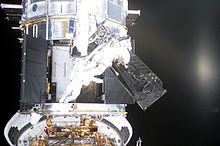Advanced Camera for Surveys
The Advanced Camera for Surveys (ACS) is a third-generation axial instrument aboard the Hubble Space Telescope (HST).
The initial design and scientific capabilities of ACS were defined by a team based at Johns Hopkins University.
It offered several important advantages over other HST instruments: three independent, high-resolution channels covering the ultraviolet to the near-infrared regions of the spectrum, a large detector area and quantum efficiency, resulting in an increase in HST's discovery efficiency by a factor of ten, a rich complement of filters, and coronagraphic, polarimetric, and grism capabilities.
Its detector consists of two butted 2048x4096, 15 μm/pixel charge-coupled devices (CCDs) for a total of 16 megapixels manufactured by Scientific Imaging Technologies (SITe).
The HRC, which has been permanently disabled since 2007 due to an electrical fault, provided ultra-sharp views over a smaller field-of-view.
The first spot was the most popular of the two, for example, for imaging circumstellar disks around nearby bright stars or the host galaxies of luminous quasars.
The Multi Anode Microchannel Array (MAMA) of the SBC is a low-background photon-counting device optimized for the ultraviolet in the wavelength range of 115–170 nm.
The instrument subsystems, including the CCD detectors, proved to be working after engineering tests, and ACS resumed science operations on July 4, 2006.





